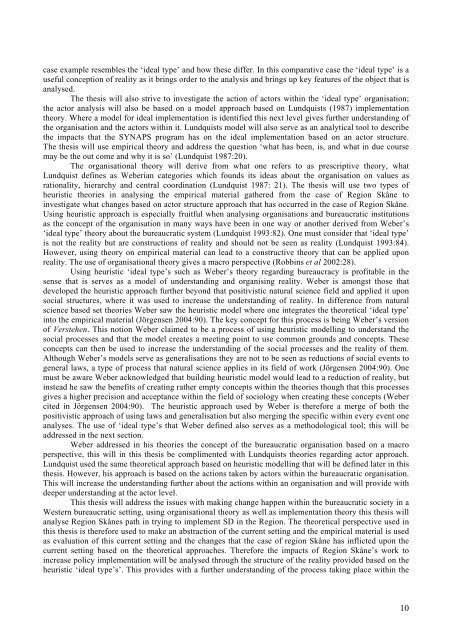From 'grey to green'- investigating the capabilities of the ... - lumes
From 'grey to green'- investigating the capabilities of the ... - lumes
From 'grey to green'- investigating the capabilities of the ... - lumes
Create successful ePaper yourself
Turn your PDF publications into a flip-book with our unique Google optimized e-Paper software.
case example resembles <strong>the</strong> ‘ideal type’ and how <strong>the</strong>se differ. In this comparative case <strong>the</strong> ‘ideal type’ is auseful conception <strong>of</strong> reality as it brings order <strong>to</strong> <strong>the</strong> analysis and brings up key features <strong>of</strong> <strong>the</strong> object that isanalysed.The <strong>the</strong>sis will also strive <strong>to</strong> investigate <strong>the</strong> action <strong>of</strong> ac<strong>to</strong>rs within <strong>the</strong> ‘ideal type’ organisation;<strong>the</strong> ac<strong>to</strong>r analysis will also be based on a model approach based on Lundquists (1987) implementation<strong>the</strong>ory. Where a model for ideal implementation is identified this next level gives fur<strong>the</strong>r understanding <strong>of</strong><strong>the</strong> organisation and <strong>the</strong> ac<strong>to</strong>rs within it. Lundquists model will also serve as an analytical <strong>to</strong>ol <strong>to</strong> describe<strong>the</strong> impacts that <strong>the</strong> SYNAPS program has on <strong>the</strong> ideal implementation based on an ac<strong>to</strong>r structure.The <strong>the</strong>sis will use empirical <strong>the</strong>ory and address <strong>the</strong> question ‘what has been, is, and what in due coursemay be <strong>the</strong> out come and why it is so’ (Lundquist 1987:20).The organisational <strong>the</strong>ory will derive from what one refers <strong>to</strong> as prescriptive <strong>the</strong>ory, whatLundquist defines as Weberian categories which founds its ideas about <strong>the</strong> organisation on values asrationality, hierarchy and central coordination (Lundquist 1987: 21). The <strong>the</strong>sis will use two types <strong>of</strong>heuristic <strong>the</strong>ories in analysing <strong>the</strong> empirical material ga<strong>the</strong>red from <strong>the</strong> case <strong>of</strong> Region Skåne <strong>to</strong>investigate what changes based on ac<strong>to</strong>r structure approach that has occurred in <strong>the</strong> case <strong>of</strong> Region Skåne.Using heuristic approach is especially fruitful when analysing organisations and bureaucratic institutionsas <strong>the</strong> concept <strong>of</strong> <strong>the</strong> organisation in many ways have been in one way or ano<strong>the</strong>r derived from Weber’s‘ideal type’ <strong>the</strong>ory about <strong>the</strong> bureaucratic system (Lundquist 1993:82). One must consider that ‘ideal type’is not <strong>the</strong> reality but are constructions <strong>of</strong> reality and should not be seen as reality (Lundquist 1993:84).However, using <strong>the</strong>ory on empirical material can lead <strong>to</strong> a constructive <strong>the</strong>ory that can be applied uponreality. The use <strong>of</strong> organisational <strong>the</strong>ory gives a macro perspective (Robbins et al 2002:28).Using heuristic ‘ideal type’s such as Weber’s <strong>the</strong>ory regarding bureaucracy is pr<strong>of</strong>itable in <strong>the</strong>sense that is serves as a model <strong>of</strong> understanding and organising reality. Weber is amongst those thatdeveloped <strong>the</strong> heuristic approach fur<strong>the</strong>r beyond that positivistic natural science field and applied it uponsocial structures, where it was used <strong>to</strong> increase <strong>the</strong> understanding <strong>of</strong> reality. In difference from naturalscience based set <strong>the</strong>ories Weber saw <strong>the</strong> heuristic model where one integrates <strong>the</strong> <strong>the</strong>oretical ‘ideal type’in<strong>to</strong> <strong>the</strong> empirical material (Jörgensen 2004:90). The key concept for this process is being Weber’s version<strong>of</strong> Verstehen. This notion Weber claimed <strong>to</strong> be a process <strong>of</strong> using heuristic modelling <strong>to</strong> understand <strong>the</strong>social processes and that <strong>the</strong> model creates a meeting point <strong>to</strong> use common grounds and concepts. Theseconcepts can <strong>the</strong>n be used <strong>to</strong> increase <strong>the</strong> understanding <strong>of</strong> <strong>the</strong> social processes and <strong>the</strong> reality <strong>of</strong> <strong>the</strong>m.Although Weber’s models serve as generalisations <strong>the</strong>y are not <strong>to</strong> be seen as reductions <strong>of</strong> social events <strong>to</strong>general laws, a type <strong>of</strong> process that natural science applies in its field <strong>of</strong> work (Jörgensen 2004:90). Onemust be aware Weber acknowledged that building heuristic model would lead <strong>to</strong> a reduction <strong>of</strong> reality, butinstead he saw <strong>the</strong> benefits <strong>of</strong> creating ra<strong>the</strong>r empty concepts within <strong>the</strong> <strong>the</strong>ories though that this processesgives a higher precision and acceptance within <strong>the</strong> field <strong>of</strong> sociology when creating <strong>the</strong>se concepts (Webercited in Jörgensen 2004:90). The heuristic approach used by Weber is <strong>the</strong>refore a merge <strong>of</strong> both <strong>the</strong>positivistic approach <strong>of</strong> using laws and generalisation but also merging <strong>the</strong> specific within every event oneanalyses. The use <strong>of</strong> ‘ideal type’s that Weber defined also serves as a methodological <strong>to</strong>ol; this will beaddressed in <strong>the</strong> next section.Weber addressed in his <strong>the</strong>ories <strong>the</strong> concept <strong>of</strong> <strong>the</strong> bureaucratic organisation based on a macroperspective, this will in this <strong>the</strong>sis be complimented with Lundquists <strong>the</strong>ories regarding ac<strong>to</strong>r approach.Lundquist used <strong>the</strong> same <strong>the</strong>oretical approach based on heuristic modelling that will be defined later in this<strong>the</strong>sis. However, his approach is based on <strong>the</strong> actions taken by ac<strong>to</strong>rs within <strong>the</strong> bureaucratic organisation.This will increase <strong>the</strong> understanding fur<strong>the</strong>r about <strong>the</strong> actions within an organisation and will provide withdeeper understanding at <strong>the</strong> ac<strong>to</strong>r level.This <strong>the</strong>sis will address <strong>the</strong> issues with making change happen within <strong>the</strong> bureaucratic society in aWestern bureaucratic setting, using organisational <strong>the</strong>ory as well as implementation <strong>the</strong>ory this <strong>the</strong>sis willanalyse Region Skånes path in trying <strong>to</strong> implement SD in <strong>the</strong> Region. The <strong>the</strong>oretical perspective used inthis <strong>the</strong>sis is <strong>the</strong>refore used <strong>to</strong> make an abstraction <strong>of</strong> <strong>the</strong> current setting and <strong>the</strong> empirical material is usedas evaluation <strong>of</strong> this current setting and <strong>the</strong> changes that <strong>the</strong> case <strong>of</strong> region Skåne has inflicted upon <strong>the</strong>current setting based on <strong>the</strong> <strong>the</strong>oretical approaches. Therefore <strong>the</strong> impacts <strong>of</strong> Region Skåne’s work <strong>to</strong>increase policy implementation will be analysed through <strong>the</strong> structure <strong>of</strong> <strong>the</strong> reality provided based on <strong>the</strong>heuristic ‘ideal type’s’. This provides with a fur<strong>the</strong>r understanding <strong>of</strong> <strong>the</strong> process taking place within <strong>the</strong>10
















